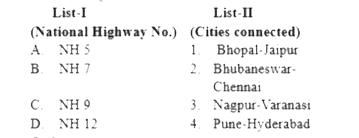Match list I with List II and select the correct answer using the codes given below the lists.

A
A-4,B-1,C-5,D-2
B
A-1,B-3,C-2,D-5
C
A-3,B-1,C-5,D-2
D
A-1,B-3,C-5,D-2
Video Solution
Text Solution
The correct Answer is:C
(A) compounds (I) and (II) both contains complex cation and anion, so they show coordinationn isomerism. (B) compound (III) and (IV) are obtained by the interchange of groups outside the coordination sphere and the ligands within the coordination sphere. therefore, they give different ions in the solution. hence, they show ionisation isomerism.
(C) compounds (V) and (VI) are linkage isomers because the ambidentate ligand, SCN has two donor atoms, i.e., it has two possibilities of attachment (SCN and NCS) with the central metal. hence, they show linkage isomerism. (D) compounds (VII) and (VIII) are obtained by the replacement of a coordinated group such as Cl− by water of hydration. hence, they show hyddrate isomerims.
|
Topper's Solved these Questions
Similar Questions
Knowledge Check
Match List I with List II and select the correct answer using the code given below the lists:
 AA-4, B-2, C-1, D-3BA-3, B-2, C-1, D-4CA-4, B-1, C-2, D-3DA-3, B-1, C-2, D-4
AA-4, B-2, C-1, D-3BA-3, B-2, C-1, D-4CA-4, B-1, C-2, D-3DA-3, B-1, C-2, D-4Match List I with List II and select the correct answer using the code given below the lists:
 AA-3, B-4, C-2, D-1BA-3, B-2 C-4, D-1CA-1, B-4, C-2, D-3DA-1, B-2, C-4, D-3
AA-3, B-4, C-2, D-1BA-3, B-2 C-4, D-1CA-1, B-4, C-2, D-3DA-1, B-2, C-4, D-3Match List I with List II and select the correct answer using the code given below the lists:
 AA-2,B-1,C-4,D-3BA-4,B-3,C-2,D-1CA-2,B-3,C-4,D-1DA-4,B-1,C-2,D-3
AA-2,B-1,C-4,D-3BA-4,B-3,C-2,D-1CA-2,B-3,C-4,D-1DA-4,B-1,C-2,D-3
Match List I with List II and select the correct answer using the code given below the list:

View SolutionMatch List I with List II and select the correct answer using the code given below the lists:

View SolutionMatch List I with List II and select the correct answer using the code given below the lists:

View SolutionMatch List I with List II and select the correct answer using the code given below the lists:

View SolutionMatch List I with List II and select the correct answer using the code given below the lists:

View Solution



